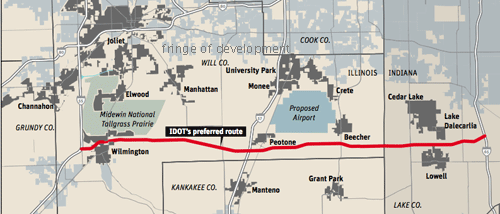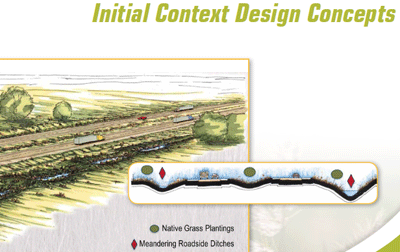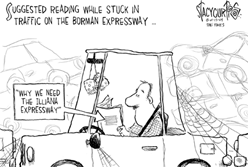![]() The Illiana Expressway today got its last necessary local approval at a meeting of the Northwest Indiana Regional Planning Commission. By a vote of 29 to 8 local officials voted to place their 10 miles of the 47 mile tollroad in the region’s longrange transportation plan. Because of vote weighting rules this translated into a 76 to 20 official result.
The Illiana Expressway today got its last necessary local approval at a meeting of the Northwest Indiana Regional Planning Commission. By a vote of 29 to 8 local officials voted to place their 10 miles of the 47 mile tollroad in the region’s longrange transportation plan. Because of vote weighting rules this translated into a 76 to 20 official result.
As in Illinois this highway is so far beyond the fringe of Chicago’s developed area it has not been considered in recent years to be worthy of placing in local metro area plans.

But it was championed by the governors of both states, and their state DOTs, who have both plunged ahead with route selection, environmental permitting, and even procurement of contractors before it was considered at the metropolitan government level.
In an attempt to limit the power of governors to unilaterally dictate to metro areas federal law requires that proposals for federally permits be on longrange metro area plans and supported by the accredited metro area body before federal authorities can sign off on permits.
Federal OK almost certain

With local metro planning bodies having now granted their required approval, federal approval now seems almost certain since the projects are quite benign in their local environmental impacts and no serious objections have been made to the permitting – although at the meeting today there were a few people complaining of losing their farms. Few people’s homes are involved since it goes through open countryside for virtually its whole 47 mile length (37 in Illinois, 10 Indiana), and avoids or mitigates any effects on wetlands and wildlife areas (see map nearby.)
In the meeting today in Portage IN local officials were heavily in favor of the project on the grounds that it will promote development, generate jobs, improve safety, and take heavy truck traffic off local surface routes and the congested Borman Expressway I-80/I-94.
Local officials have little self-interest in questioning the value of the project since they are not being asked to commit local funds to it, and they will likely be out of office by the time its financial deficits become a draw on state budgets.
Conservatives cite private investor involvement
 Plus the project has been protected from conservative criticism by the impression that its financing puts risks on the private sector. The procurement is for a so-called ‘public private partnership.’
Plus the project has been protected from conservative criticism by the impression that its financing puts risks on the private sector. The procurement is for a so-called ‘public private partnership.’
The area’s conservative US senator Dan Coates was quoted today as saying the private sector involvement was a “creative solution” and that the project “leverages private sector funding.”
And Indiana Business Report for example wrote today: “Private investors will (now) be sought for the project.”
This version of the project tends to deflect concerns that it could become drag on state and local budgets.
In fact both Illinois and Indiana officials quickly discovered there is no private sector interest in the project as a toll concession in which the investors take the risk (and reward) of traffic and revenue. So the procurements by each state are going forward as ‘availability payments’ contracts in which the state commits to payments to the investors regardless of traffic and revenue.
Availability payments put major risk on state taxpayers
The investors do assume the risks in delivering the finished project on time and on budget, and get the rewards for doing it ahead of time and below budget – just as in a fixed price design-build contract. And they assume some risks in committing to maintain the road over the years although those are not very large.
But the biggest risk – traffic and revenue risk – is carried by each state government, and therefore by state taxpayers, not by investors. The state will have to make up the shortfall if its net toll revenues don’t come up to the cost of the availability payments.
Major problem of the project was described in a Chicago Tribune editorial this week as its location “through the middle of mostly nowhere.”

Planning staff in NW Indiana declined to report their assessment of the project, probably realizing its support there was a foregone conclusion. Those in Illinois (CMAP) panned the project, noting that the state DOT refused them access to numbers supposedly supporting claims it would pay its way.
CMAP staff said their best estimates were that it would require state subsidies of $440m to $1.1b.
They said any reductions in traffic congestion would be “negligible,” and economic development benefits were very “uncertain” – both because of its location so far beyond the edge of development.
It is so far out of the major east-west route for truck traffic in the southern part of the metro area it is unclear whether trucks will gain any time savings at all compared with the Borman. The new tolled route will be considerably further to travel because of the addition north-south travel required to access it.
Unusual for a modern toll project there still is no full traffic and revenue forecast yet publicly available for the Illiana.
Availability payments contracts however can proceed without one since the investors can raise capital based on the overall credit standing of the state, and don’t need to present traffic and revenue projections to investors.


